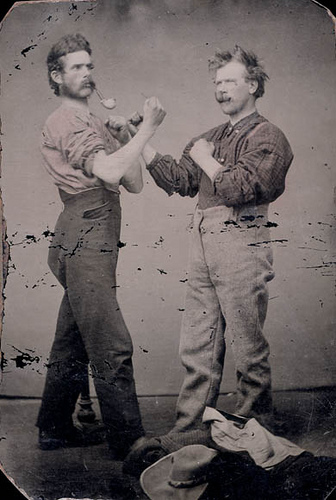 I LOVE Conflict. The Importance of Conflict in Organizations
I LOVE Conflict. The Importance of Conflict in Organizations
Organizations devote huge amounts of money to conflict and communications: in trying to prevent it, and trying to manage it when it does arise. So it is well worth devoting time to understanding this phenomenon that is conflict. Where does it come from? And why does it arise with such predictable regularity?
We can see conflict in terms of two fundamental human drives. The first is the drive toward autonomy. The second is the drive towards connectedness. If we can learn to see these forces at play in the conflicts we encounter in our lives, we might uncover new ways to respond to these conflicts, with benefits to all the individuals and organizations involved.
Defining Autonomy and Connectedness
In any workplace, the drives toward both autonomy and connectedness are inevitably present. The drive toward autonomy is the drive towards personal development and self-determination. We see it, for instance, when an employee sets their sights on promotion or puts forward a radical new proposal. The drive to connectedness, meanwhile, is the desire to unite, to relate with other people. We see it when people join together to form friendships, alliances, partnerships or networks. Both are universal human drives that all of us experience, to varying degrees, throughout our lives. A number of conflict management authorities have based their theory and practice on the same two drives. Bush and Folger’s model of Transformative Mediation focuses on restoring the disputing parties’ sense of empowerment (i.e. autonomy) and their ability to recognize one another’s perspectives (i.e. connectedness).
Autonomy, connectedness and the genesis of conflict
Both autonomy and connectedness are understandable, even admirable, human drives. The problems emerge when we feel they are under threat. Suppose an employee seeking promotion finds her ambition blocked by a colleague. The colleague’s behavior, in turn, is motivated in some way by the drive toward autonomy or connectedness: perhaps she wants the position for herself, or perhaps she fears the change would disrupt team dynamics. The perception of each that the other is blocking their needs can trigger a breakdown in the relationship leading to out-and-out conflict. The dual drives toward autonomy and connectedness can also give rise to inner conflict. For instance, when we desire something for our own advancement, but fear the effect on our relationship with others and find ourselves fighting to balance these apparently conflicting needs. Every conflict is in fact a complex web of frustrated desires, within and between the people involved: the desire to confirm one’s individual identity and the desire to be in relationship with others.
Compassion, creativity and growth
Now, how can we use these insights to handle work side conflict?
First of all, it may be that simply understanding conflicts in terms of the frustrated desires for autonomy and connectedness can lead to more compassion towards the people we find ourselves in conflict with. Each of us can relate to the need for both autonomy and connectedness, in some form and to some degree, in our own lives. This might make it easier for us to understand the behavior even of someone whom we consider to be our aggressor. In some cases, this compassion may even be enough to bring about reconciliation or resolution. And even if not, the glimmer of compassion, however fleeting, can help to make the situation easier to bear for all parties, and reduce the bitterness of relations between them. Seeing conflict through the prism of autonomy and connectedness can also be of help to third parties observing or managing the conflict from the outside. When an HR professional is brought into a conflict situation, it may be easier for them to handle the case with impartiality and fairness if they are able to find compassion for both of the parties involved.
Another benefit that can emerge from seeing conflict in this way is greater creativity in addressing the conflict. When disputing parties begin to rediscover a shared humanity, the chances of finding a mutually beneficial outcome multiply. They are more likely to see the situation as a joint problem to be solved, or even better, a joint opportunity to be explored. They are more likely to open up to one another and share information about their true feelings and needs, which can trigger new ideas and creative compromises. In particular, once the underlying needs of both sides are out in the open, it becomes easier to imagine alternative ways to meet those needs, with greater benefits for all.
Finally, by better understanding the forces driving the conflicts in our lives, we are better able to use these conflicts as opportunities for growth and self-development. We are better placed to recognize the patterns that recur in the conflicts we experience, for instance a pattern of sacrificing one’s own needs (autonomy) for the sake of peaceful relationships with others (connectedness), or vice versa. These insights can help us better manage the balance of autonomy and connectedness in our lives. This, in turn, can reduce the level of conflict – both internal and inter-personal – that we generate. Through each experience of conflict, we can become more self-aware and make better choices, instead of acting out of unconscious habits which reappear in each new conflict situation, often with increasing violence.
To conclude, by seeing the drives towards autonomy and connectedness as the underlying forces behind conflict, we may reap important benefits:
- we may find greater compassion towards people in conflict
- we can increase our chances of finding creative solutions which benefit the individuals and organizations involved
- we can even transform the conflicts in our lives into opportunities for growth and self-development.
Ultimately our experience of conflict may teach us that the distinction between self and other, which has proved so useful in explaining the existence of conflict, is in fact less distinct than we think.
Personality Types and common goals
~ It takes a lot of people to build a world and we all think we are very unique, but there are only a few higher goals for all mankind and they do not include distinction by money or force. Knowing your personality type and achieving to step up your road towards personal evolution will make you more satisfied than anything else.
It takes a lot of people to build a world and we all think we are very unique, but there are only a few higher goals for all mankind and they do not include distinction by money or force. Knowing your personality type and achieving to step up your road towards personal evolution will make you more satisfied than anything else.
If you can then conclude your core talents in this evolution, then your journey will be heavenly…. on earth.


